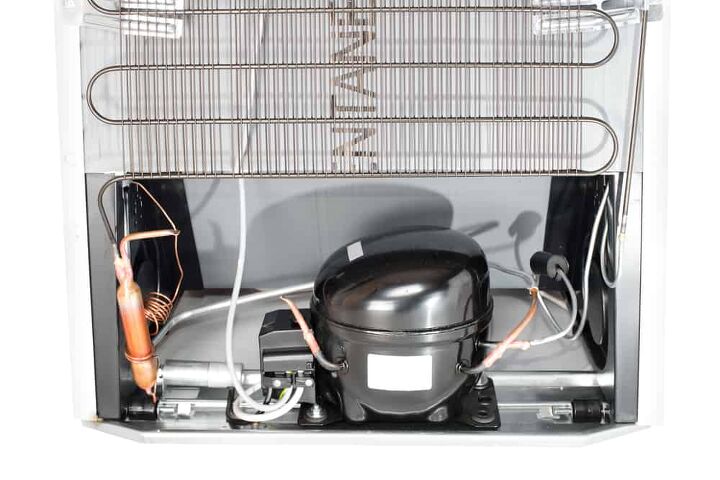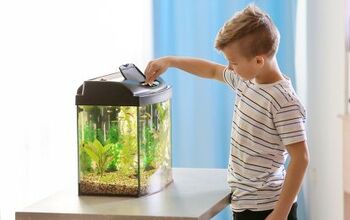Refrigerator Compressor Is Running But Not Cooling? (Fix It Now!)

There is arguably no more important part of your refrigerator than the compressor. It provides the refrigerant that your refrigerator requires to cool your food items. So, what does it mean when your refrigerator compressor is running but not cooling?
Dirty condenser coils or a broken evaporator fan can prevent your refrigerator compressor from cooling when it runs. You can also prevent your refrigerator compressor from cooling if you block the vents with food items or containers. Inspect the evaporator coil and unplug your refrigerator for 48 hours if it is frozen.
Luckily, several quick fixes don’t require you to replace the compressor. Follow along as we explore what you can do when your refrigerator compressor is running but not cooling.
Do You Need Appliance Installation or Replacement?
Get free, zero-commitment quotes from pro contractors near you.

Refrigerator Compressor Is Running But Not Cooling
The most common reason that a refrigerator compressor is running but not cooling is that the evaporator fan is broken. Otherwise, a compressor will run without cooling if the evaporator coil is frosted. Problems with circulation in your refrigerator or blocked vents are also common, and that’s why it’s important to troubleshoot.
The compressor pushes refrigerant into the coils in your refrigerator that ultimately allow it to cool. Compressors initially create heat which forms gas and eventually cools down. Let’s take a look at how you can troubleshoot when your refrigerator compressor is running but not cooling.
1. Check the Thermostat
Check the temperature on your refrigerator’s thermostat before you address the compressor. It is easy to accidentally change the temperature on the thermostat in your fridge. Your compressor may run well but your refrigerator won’t cool if the temperature is above 40 degrees Fahrenheit.
Adjust the temperature so that it is at 40 degrees Fahrenheit or below. Otherwise, your compressor will run without cooling your refrigerator. You can either find the thermostat in the back of your refrigerator or at the bottom on over-under units.
2. Shut the Door
Make sure that your refrigerator door is completely shut if the compressor is running but not cooling. Cool air will escape the unit if you don’t shut the door completely, and it can cause your food to spoil. Inspect the seal on your refrigerator doors to make sure it isn’t damaged or stuck.
A torn seal, or gasket, can make it impossible for your refrigerator to retain coolness as well as it could. You may be able to shut the doors, but the lack of a strong seal will waste cool air. This can explain why your compressor is running but not cooling the refrigerator.
3. Blocked Vent
The vents in the back of your refrigerator allow cool air to circulate within the unit. It is easy to accidentally block the vents with food items or containers. Reorganize your refrigerator and make sure that there is nothing in the way of the vents. Check to make sure that nothing is blocking the vents in your freezer as well.
Broken Evaporator Fan
You shouldn’t generally be able to hear an evaporator fan as it runs if it is healthy. Open your refrigerator door and listen for chirps that indicate the fan is broken. You can find the evaporator fan right by the evaporator coils covered by a protective plate.
Remove the evaporator fan’s cover and inspect it for damage. Unplug the refrigerator, disconnect the fan’s wires, and pull it out by hand. Take a picture of the connections before you remove the motor so that you can attach the new one properly.
You likely only need to replace the motor, and replacement motors typically cost $35. Simply reattach the wires to the new motor and match them by color. Place the fan and shroud back over the motor, plug your refrigerator back in, and test it out.
Broken Start Relay
If the start relay is broken, signals from the thermostat won’t reach the compressor and fan. The start relay is usually mounted to the compressor. It can help start the compressor during the cooling cycle.
You can sometimes hear a clicking sound as the compressor turns on and off if the start relay is faulty. If you hear the clicking, unplug the relay from the compressor and shake it. If it rattles inside, you need to replace the start relay.
Dirty Condenser Coils
Dirty condenser coils can prevent your compressor from cooling the refrigerator when it is running. Professionals recommend that you clean your condenser coils every 6 months so that they work properly. Dirty coils can cause the thermostat in your refrigerator to fail.
Unplug your refrigerator and open the rear access panel to expose the condenser coils. Inspect the condenser coils for dirt, debris, and scraps of food. Clean the coils with a rag, brush, or pressurized air to remove debris. Plug your refrigerator back in and see if your refrigerator starts cooling again as intended.
The Thermistor Malfunctioned
The thermistor is a sensor connected to the refrigerator control board. It monitors the air temperature inside the refrigerator. If the thermistor is defective, the refrigerator will not cool effectively.
If the thermistor is broken, you need to replace it.
Do You Need Appliance Installation or Replacement?
Get free, zero-commitment quotes from pro contractors near you.

Related Questions
At what point should I throw away my refrigerator and purchase a new one?
The average lifespan of a refrigerator varies depending on the brand. The typical refrigerator lasts about 10 to 13 years, but some can last up to 20 years. The key to prolonging the life of your refrigerator is regular maintenance. If the cost of the repair exceeds the price of a new refrigerator, buy a new one. Within three years of purchasing a new refrigerator, a top-freezer will need repairs, on average. You will need to perform additional maintenance in three to six years. After roughly seven years, you will need to replace it. If you purchase a side-by-side refrigerator, you should expect it to need repairs within the first five years. After seven years, you will need to repair bottom-freezers. The side-by-side and bottom-freezer will most likely require additional repairs in the future.
What is the average price of a new refrigerator?
The price and installation of a new refrigerator usually cost around $1,500. The low-end price of refrigerators is $800, while others can cost as much as $1,200. If you want to get the best bargain on your refrigerator, buy during late April, May, and early June. This is because the heat of the summer months usually results in broken refrigerators and freezers. Because of this, manufacturers have new models ready for the summer months.

Stacy Randall is a wife, mother, and freelance writer from NOLA that has always had a love for DIY projects, home organization, and making spaces beautiful. Together with her husband, she has been spending the last several years lovingly renovating her grandparent's former home, making it their own and learning a lot about life along the way.
More by Stacy Randall











![How Much Weight Can a 4×4 Support Horizontally? [It Depends!]](https://cdn-fastly.upgradedhome.com/media/2023/07/31/9070333/how-much-weight-can-a-44-support-horizontally-it-depends.jpg?size=350x220)















